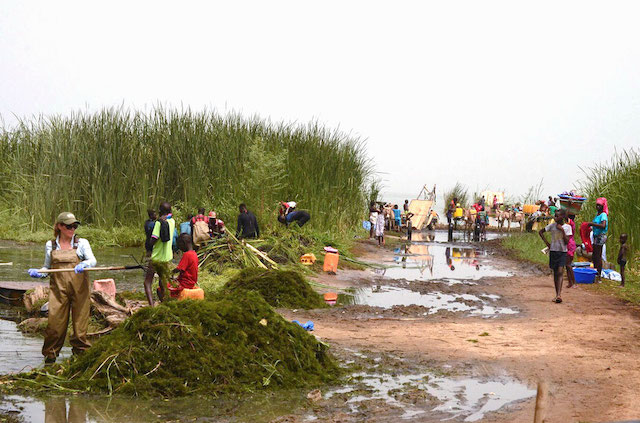How removing water vegetation improves health, economy of community
Schistosomiasis is a parasitic disease caused by snail-transmitted flatworms.
According to the Centers for Disease Control and Prevention, the disease—which can cause scarring and inflammation of the liver, intestines and bladder, leading to anemia, malnutrition and learning difficulties, particularly in children—affects some 200 million people worldwide.
The disease is most often seen in parts of Africa, South America, the Caribbean and Asia where people use contaminated freshwater for bathing, drinking and cooking.
“Infected humans pass eggs of the Schistosoma parasite in feces or urine, and in areas that do not have adequate sanitation, those eggs often find their way into local bodies of water,” explained USF College of Public Health doctoral student Caitlin Wolfe, who recently co-authored a study examining how removing vegetation that acts as a habitat for the snails can reduce rates of the disease.
“Once in the water, the microscopic eggs hatch into miracidia that infect the snails,” she added. “The parasites then grow and mature into their next life cycle phase, cercaria, in the snail. Infected snails release the cercaria into the water, and the cercaria swim through the water and infect humans when they use infested bodies of water.”

Wolfe and her coauthors, including the principal investigator Dr. Jason Rohr, a former USF professor of integrative biology who currently teaches at Notre Dame, published their study, “A planetary health innovation for disease, food and water challenges in Africa,” in July in the journal Nature.
Wolfe and her colleagues performed their research in Senegal, where 99% of host snails are captured in the freshwater plant Ceratophyllum demersum. Because of the region’s arid soil, fertilizer is often used on crops, and that fertilizer gets into the water supply during heavy rains and subsequent surface runoff.
“More fertilizer in the water leads to more plants and more algae, which leads to more snails, which leads to more schistosomiasis,” she said.
Wolfe and her study co-authors hypothesized that if they could remove vegetation from the waterways and then compost that vegetation to be used as animal feed (the vegetation is safe for the animals; worms need a human host do their damage), they could reduce rates of schistosomiasis and create better access to waterways while increasing food production.
And, it turns out, they were right.
In the villages where the floating vegetation was removed (by hand), schoolchildren had nearly a 1.5 times lower rate of schistosomiasis, waterways stayed clearer and the composted vegetation-turned-animal feed turned out to be 41 to 179 times cheaper than traditional feed.
“Thankfully,” said Wolfe, who’s concentrating in global communicable disease, “the findings of this study supported the hypothesis! We’ve known that certain snail species have an affinity for specific plants in specific locations (in northern Senegal, it’s the floating vegetation called ceratophyllum), so the notion of removing the plants that these snails like to feed on is something that has been suggested and discussed previously. But this study was one of the first to demonstrate concrete evidence for this intervention. The hope is that because there are additional benefits beyond just reducing transmission of a parasitic disease—such as increased agricultural output when the vegetation is composted and used as animal feed—there will be enough buy-in at local levels to support this intervention.”
Story by Donna Campisano, USF College of Public Health
